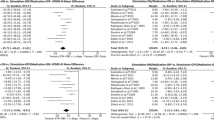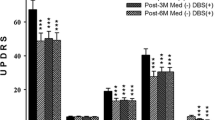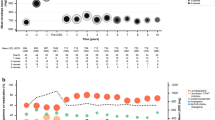Abstract
Bilateral subthalamic nucleus deep brain stimulation (STN DBS) improves motor fluctuations and dyskinesias in patients with Parkinson's disease (PD). Dyskinesia improvement with STN DBS is believed to result entirely from levodopa reduction. However, some studies suggest that STN DBS may also directly suppress dyskinesias. To determine whether bilateral STN DBS improves dyskinesias beyond what would be expected from levodopa reduction alone, we analyzed pre-operative and post-operative dyskinesia scores (sum of MDS-UPDRS items 4.1 and 4.2) from 61 PD patients with bilateral STN DBS. A multiple regression model (adjusted for disease severity, disease duration, active contacts above the STN, use of amantadine, high pre-operative levodopa-equivalent dose (LED), sex, and interaction between active contacts above the STN and amantadine use) was created to describe the relationship between dyskinesia scores and LED prior to DBS. Using this model, a post-operative dyskinesia score was estimated from post-operative LED and compared to the actual post-operative dyskinesia score. The regression model was statistically significant overall (p = 0.003, R2 = 0.34, adjusted R2 = 0.24). The actual post-operative dyskinesia score (1.0 ± 1.4) was significantly lower than the score predicted by the model (3.0 ± 1.1, p < 0.0001). Dyskinesias after STN DBS improved more than predicted by levodopa reduction alone. Our data support the idea that STN stimulation may directly improve dyskinesias.

Similar content being viewed by others
References
Chou KL et al (2018) The spectrum of “off” in Parkinson’s disease: what have we learned over 40 years? Parkinsonism Relat Disord 51:9–16. https://doi.org/10.1016/j.parkreldis.2018.02.001
Coleman RR, Kotagal V, Patil PG, Chou KL (2014) Validity and efficacy of screening algorithms for assessing deep brain stimulation candidacy in parkinson disease. Mov Disord Clin Pract 1:342–347. https://doi.org/10.1002/mdc3.12103
Conrad EC, Mossner JM, Chou KL, Patil PG (2018) Atlas-independent, electrophysiological mapping of the optimal locus of subthalamic deep brain stimulation for the motor symptoms of parkinson disease. Stereotact Funct Neurosurg 96:91–99. https://doi.org/10.1159/000486643
Follett KA et al (2010) Pallidal versus subthalamic deep-brain stimulation for Parkinson’s disease. N Engl J Med 362:2077–2091. https://doi.org/10.1056/NEJMoa0907083
Kim JH, Chang WS, Jung HH, Chang JW (2015) Effect of subthalamic deep brain stimulation on levodopa-induced dyskinesia in Parkinson’s disease. Yonsei Med J 56:1316–1321. https://doi.org/10.3349/ymj.2015.56.5.1316
Krack P, Pollak P, Limousin P, Benazzouz A, Deuschl G, Benabid AL (1999) From off-period dystonia to peak-dose chorea. The clinical spectrum of varying subthalamic nucleus activity. Brain 122(Pt 6):1133–1146
Nimura T et al (2005) Attenuation of fluctuating striatal synaptic dopamine levels in patients with Parkinson disease in response to subthalamic nucleus stimulation: a positron emission tomography study. J Neurosurg 103:968–973. https://doi.org/10.3171/jns.2005.103.6.0968
Nutt JG, Woodward WR (1986) Levodopa pharmacokinetics and pharmacodynamics in fluctuating parkinsonian patients. Neurology 36:739–744. https://doi.org/10.1212/wnl.36.6.739
Oyama G et al (2012) GPi and STN deep brain stimulation can suppress dyskinesia in Parkinson’s disease. Parkinsonism Relat Disord 18:814–818. https://doi.org/10.1016/j.parkreldis.2012.03.022
Patil PG, Conrad EC, Aldridge JW, Chenevert TL, Chou KL (2012) The anatomical and electrophysiological subthalamic nucleus visualized by 3-T magnetic resonance imaging. Neurosurgery 71:1089–1095. https://doi.org/10.1227/neu.0b013e318270611f (discussion 1095)
Ramirez-Zamora A, Ostrem JL (2018) Globus pallidus interna or subthalamic nucleus deep brain stimulation for Parkinson disease: a review. JAMA Neurol 75:367–372. https://doi.org/10.1001/jamaneurol.2017.4321
Tomlinson CL, Stowe R, Patel S, Rick C, Gray R, Clarke CE (2010) Systematic review of levodopa dose equivalency reporting in Parkinson’s disease. Mov Disord 25:2649–2653. https://doi.org/10.1002/mds.23429
Tran TN, Vo TNN, Frei K, Truong DD (2018) Levodopa-induced dyskinesia: clinical features, incidence, and risk factors. J Neural Transm (Vienna) 125:1109–1117. https://doi.org/10.1007/s00702-018-1900-6
Vizcarra JA et al (2018) Subthalamic deep brain stimulation and levodopa in Parkinson’s disease: a meta-analysis of combined effects. J Neurol. https://doi.org/10.1007/s00415-018-8936-2
Warren Olanow C et al (2013) Factors predictive of the development of Levodopa-induced dyskinesia and wearing-off in Parkinson’s disease. Mov Disord 28:1064–1071. https://doi.org/10.1002/mds.25364
Acknowledgements
James Mossner receives research support from a TL1 training grant from the NIH (TL1TR002242). Dr. Patil has received grants from the National Institutes of Health (5R01GM111293-03, 5R01GM098578-08, 1U24NS107158-01, 1R01NS105132-01A1) and Taubman Medical Research Institute. Dr. Chou receives research support from the National Institutes of Health (NS091856-01, NS10061102, NS107158), participates as a site-PI in clinical trials sponsored by the Parkinson Study Group (STEADY-PD III, SURE-PD3, NILO-PD) receives royalties from UpTo Date and Springer Publishing and served as a consultant for Accordant, Boston Scientific and Sunovion.
Funding
This research did not receive any specific grant from funding agencies in the public, commercial, or not-for-profit sectors.
Author information
Authors and Affiliations
Corresponding author
Ethics declarations
Informed consent
It was obtained from all patients and the study was approved by the Medical Institutional Review Board of the University of Michigan.
Additional information
Publisher's Note
Springer Nature remains neutral with regard to jurisdictional claims in published maps and institutional affiliations.
Rights and permissions
About this article
Cite this article
Mossner, J.M., Patil, P.G. & Chou, K.L. Subthalamic nucleus deep brain stimulation improves dyskinesias in Parkinson’s disease beyond levodopa reduction. J Neural Transm 126, 1479–1483 (2019). https://doi.org/10.1007/s00702-019-02076-y
Received:
Accepted:
Published:
Issue Date:
DOI: https://doi.org/10.1007/s00702-019-02076-y




